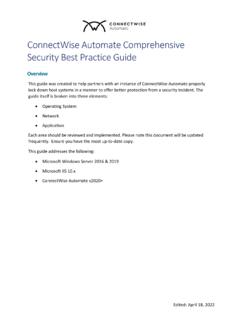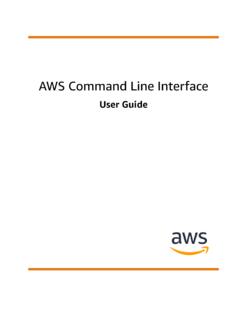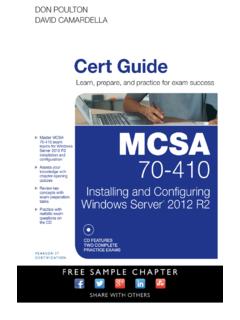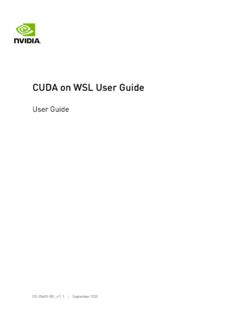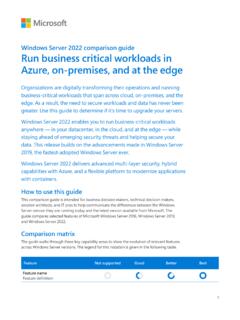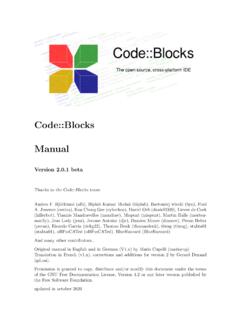Transcription of ConnectWise Control Comprehensive Security Best Practice …
1 ConnectWise Control Comprehensive Security Best Practice Guide This guide was created to help Partners with an instance of ConnectWise Control properly lock down host systems in a manner to offer better protection from a Security incident. The guide itself is broken into three elements: Operating System, Network and Application. Each of these areas should be reviewed and implemented. Please note this document will be updated frequently. Ensure you have the most up to date copy. This guide addresses the following: Microsoft windows Server 2016 & 2019. Microsoft IIS ConnectWise Control This guide serves as an enhancement (or addition to) the ConnectWise Control Security Guide: Security_guide The linked ConnectWise Control Security Guide contains steps to configure and secure the following: Securing Session Traffic Cloud Administrator Lockout Security Configurations o Controlling user Permissions Restrict a host to access a single remote machine Restrict access to remote machines by organization o Two-Factor Authentication o Configuring SSL.
2 Cloud Instances On-Premises Configuring access to Your ConnectWise Control Server o Blocking and Restricting Access to Your ConnectWise Control Site o Automatically Force a Host to Disconnect from a Session user Authentication Options o Internal Authentication o windows active Directory & LDAP. o External user Authentication Logging and Auditing o Video or "Extended" Auditing o Login Auditing Revoke user Access Recommended Extensions for Security o Security Toolkit 1. Version 2 (Edited August 4, 2021). o Report Manager or Reports Page Guest Security o Exiting a Support Session o Consent to Control Partner On premises and cloud installations This section is intended for partners that have installed ConnectWise Control on an on-premises server or in on a self-hosted cloud virtual private server (VPS).
3 For ConnectWise Hosted Control partners, this guidance in this section is just for your information, since you are unable to make these changes at the server level. All the actions below have been taken in your instance on the hosted platform. Operating System Hardening Guidelines (Before application install). Review the Security Technical Implementation Guides (STIGs) as a methodology to secure Microsoft Server 2016 and 2019. For AWS cloud instances, many of the High and Medium standards are addressed inside the AWS Standard Server AMI. The user account and STIGs information below are strongly recommended for the ConnectWise Control server.
4 The IT Nation Secure team is recommending Partners implement the STIGs located here: Server 2016 Server 2019 IIS 10 - STIG Items to Modify Run Microsoft Group Policy Editor from the " " command. Group Policy Editor controls a wide range of options and can be used to enforce settings and change the defaults for applicable users and services. 1. Disable Anonymous Network Access. Do not allow anonymous enumeration of SAM accounts and shares. Configure the policy value for Computer Configuration > windows Settings > Security Settings > Security Options > Network access: Do not allow anonymous enumeration of SAM accounts and shares to Enabled. 2.
5 Version 2 (Edited August 4, 2021). 2. Disallow Autoplay for non-volume devices. Configure the policy value for Computer Configuration > Administrative Templates > windows Components > AutoPlay Policies > Disallow Autoplay for non-volume devices to Enabled For Server 2016: Computer Configuration > windows Settings >. Security Settings > Local Policies > Security Options 3. Set the default behavior for AutoRun. Configure the policy value for Computer Configuration > Administrative Templates > windows Components > AutoPlay Policies > Set the default behavior for AutoRun to Enabled with Do not execute any autorun commands selected. 4. Turn off AutoPlay.
6 Configure the policy value for Computer Configuration > Administrative Templates > windows Components > AutoPlay Policies > Turn off AutoPlay to Enabled with All Drives selected. The above setting is discussed in some detail within the Certify Fundamentals course available from the ConnectWise University. 5. Ensure NO ONE is added to Act as part of the operating system in the GPO. Navigate to Local Computer Policy > Computer Configuration >. windows Settings > Security Settings > Local Policies > user Rights Assignment. If any accounts or groups (to include administrators), are granted the Act as part of the operating system user right, the accounts should be removed immediately from this policy object.
7 3. Version 2 (Edited August 4, 2021). 6. Disable Always install with elevated privileges. Configure the policy value for Computer Configuration > Administrative Templates > windows Components > windows Installer > Always install with elevated privileges to Disabled. This setting appears both in the Computer Configuration and user Configuration folders. To make this setting effective, it must be configured within both folders. The Not Configured setting will use the user 's current permission set. This is part of the reason why having TWO accounts (a normal user and a separate Privileged account) is very important. Please also note the Caution item in the graphic below noting that skilled users can take advantage of the permissions this setting grants in order to change their privileges and gain permanent access to restricted files and folders.
8 7. Do not use administrative accounts with applications that access the Internet Microsoft windows Server administrative accounts must not be used with applications that access the Internet, such as web browsers, or with potential Internet sources, such as email. Using applications that access the Internet or have potential Internet sources using administrative privileges exposes a system to compromise. If a flaw in 4. Version 2 (Edited August 4, 2021). an application is exploited while running as a privileged user , the entire system could be compromised. Web browsers and email are common attack vectors for introducing malicious code and must not be run with an administrative account.
9 Since administrative accounts may generally change or work around technical restrictions for running a web browser or other applications, it is essential that policy require administrative accounts to not access the Internet or use applications such as email. The policy should define specific exceptions for local service administration. These exceptions may include HTTP(S)-based tools that are used for the administration of the local system, services, or attached devices. Whitelisting can be used to enforce the policy to ensure compliance. Disable Server Headers in Microsoft IIS. Web applications may unintentionally disclose information about their underlying technologies through headers, error messages, version numbers, or other identifying information.
10 An attacker can use that information to research vulnerabilities in those technologies to attack the application to breach the system. 1. Open PowerShell as Administrator: 2. To validate that IIS Server Headers are not disabled, copy and paste: Get-WebConfigurationProperty -pspath machine/webroot/apphost -filter ' ' -name 'removeServerHeader'. 3. Use the following PowerShell command to disable server headers in IIS10: Set-WebConfigurationProperty -pspath MACHINE/WEBROOT/APPHOST -filter " " -name "removeServerHeader". -value "True". 4. Verify server headers via the following from an elevated command prompt: curl -H 'Host:' https://localhost/aspnet_client -I.
